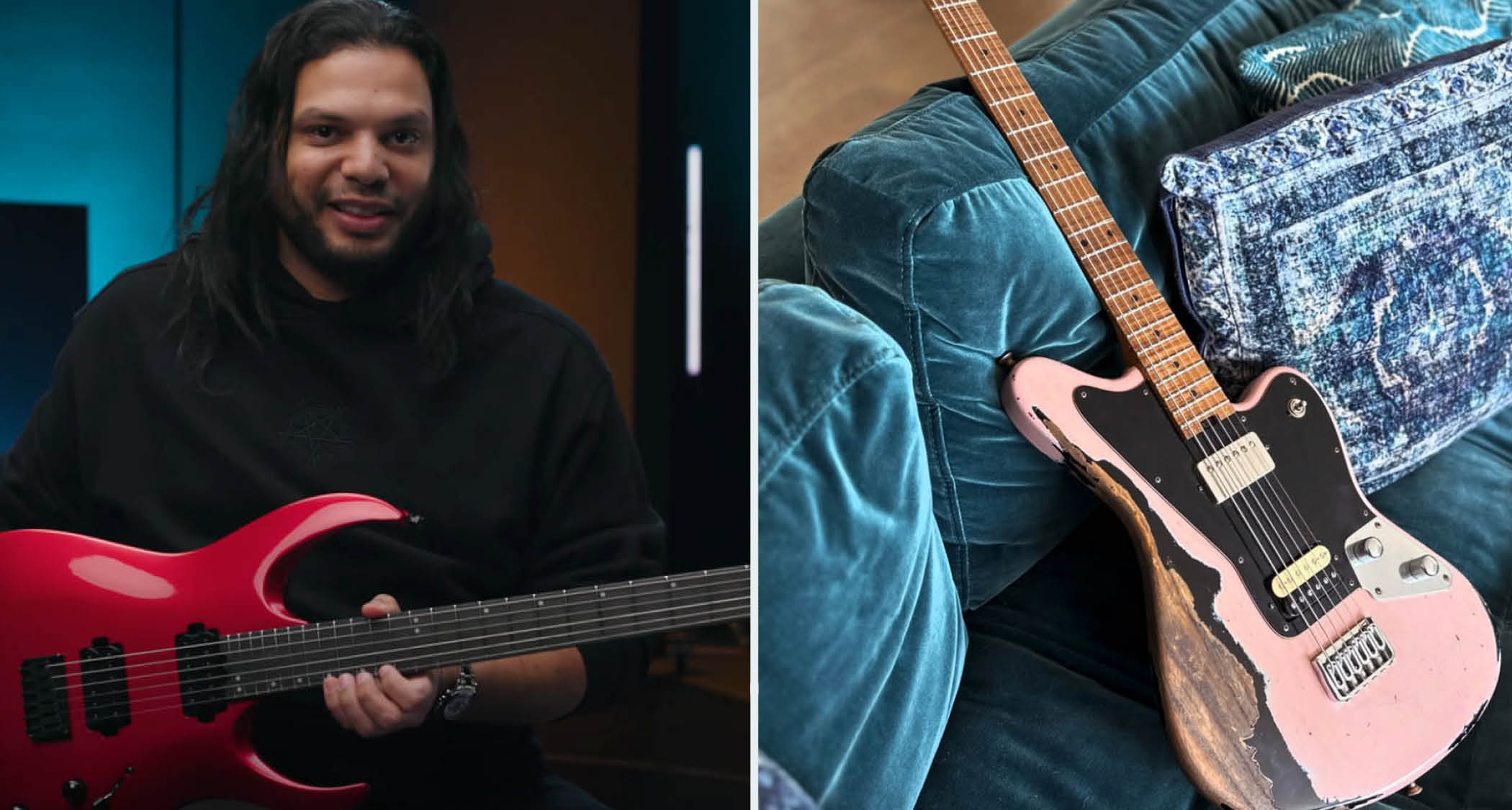“It’s a really wild, weird tuning, and something that low would just not work if you didn’t have a 30-inch scale”: Periphery’s Misha Mansoor on how the Fender Bass VI inspired his Jackson baritone offset – and the “absurd” super-low tuning he uses on it
With Charvel Surfcaster bodies and Strat headstocks, Mansoor's Frankenstein Jacksons are the coolest metal guitars you'll see, and the tuning they've inspired is crazy even by baritone standards

Misha Mansoor and Jackson have just refreshed the Periphery guitarist’s signature guitar, offering the Juggernaut in sweet new finishes with the choice of an EverTune bridge or a six-saddle hard-tail, and of course this is great news for anyone looking for a state-of-the-art metal guitar.
But what is the story behind Mansoor’s offset baritones that the Jackson Custom Shop’s Master Builder Pasquale “Pat” Campolattano made him? Mansoor has one in Shell Pink, one in green, both heavy relic’d with a 30” scale. They've got the body of a Charvel Surfcaster and the headstock of a Fender Stratocaster.
Well, it all started with the Bass VI. Speaking to MusicRadar, Mansoor says it was the vintage Fender six-string bass-electric guitar hybrid that had him jonesing for a new offset low-end adventure.
“I saw loads playing baritones, and I saw people doing cool stuff on Bass VIs,” says Mansoor. “And I thought, ‘I wanna get a Bass VI. Let me play around with that.’ And then I was like, ‘This is such a cool instrument. I wonder what this would be like with humbuckers and my sort of setup.’ We ended up with my Custom Shop baritones.
“It was really more the answer to a question – there was nothing quite like it out there. Like, if there was something out there that I could buy, I probably would have bought it, but there isn’t, so I had it made. Now they are turning out to be these really inspirational instruments.”
The specs are kind of ridiculous. Dream guitar material. Take the Shell Pink model. There’s a roasted ash body, roasted flame maple neck and fingerboard, with jumbo stainless steel frets and the 20” fretboard radius that you’ll find on his Juggernauts, too. A set of Mansoor's Bare Knuckle Ragnarok humbuckers provide the firepower, a Hipshot bridge the stability.
Of the two baritones, Mansoor admitted on Instagram that he prefers the pickup position on the green one, and was thinking of getting the Shell Pink model’s bridge humbucker moved closer to the bridge. But the key spec is that 30” scale length, because it is allowing him to explore some really crazy low tunings on a six-string guitar.
Want all the hottest music and gear news, reviews, deals, features and more, direct to your inbox? Sign up here.
A post shared by Misha Mansoor (@mishaperiphery)
A photo posted by on
When he got the Shell Pink model, Mansoor said it was strung up with a Horizon Devices Bulb 8-String electric guitar strings, using the low six strings only and tuned to Drop E. But Mansoor tells us that the tuning these guitars are in at the moment that takes Periphery's super-weighty drop-octave tuning even further into bass guitar territory – an “absurd” tuning that you can only get away with on a 30” scale baritone.
A post shared by Misha Mansoor (@mishaperiphery)
A photo posted by on
“The tuning I’m messing with right now is Bb,” he says, with a chuckle. “We have this tuning that we use for this song called Reptile – and some other stuff on a six string – which is GGCFAD. So it’s Drop C, but the low string is dropped to a G, so you get an octave relationship between the lowest two strings. If you were to drop that whole tuning down to where the lowest string is a Bb, that’s the tuning that we’re using.
“It’s actually so low that we end up doing unison on the bass in Bb. So it’s like low Bb. It’s barely audible but you’ve got the octave there to sort of make it audible. I don’t know. It’s a really wild, weird tuning, and something that low would just not work if you didn’t have a 30-inch scale.”
Oftentimes, alternate tunings require more than just a recalibration of your gear and a heavier set of strings. Your fretting hand has got to adapt to the new fretboard geography. Your head has to get around the possibilities for new chord voicings – then you've got to remember them.
Your left-hand muscle memory generally works... it’s a tuning relationship that I am fairly familiar with
But this octave situation on the fifth and sixth strings means Mansoor's fretting hand knows what it’s doing even if this is 100 per cent a WTF tuning for the ears, the speaker cone, everything else.
“The rest of the strings still have got your typical six-string relationship and that means your moves and your left-hand muscle memory generally works,” says Mansoor. “Also it’s a tuning relationship that I am fairly familiar with. It has just been pretty inspiring to play around with that.”
You can read our full interview with Misha Mansoor, coming soon to MusicRadar.
Jonathan Horsley has been writing about guitars and guitar culture since 2005, playing them since 1990, and regularly contributes to MusicRadar, Total Guitar and Guitar World. He uses Jazz III nylon picks, 10s during the week, 9s at the weekend, and shamefully still struggles with rhythm figure one of Van Halen’s Panama.
You must confirm your public display name before commenting
Please logout and then login again, you will then be prompted to enter your display name.


